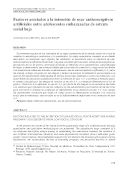Resultados: visualización detallada
Registro 1 de 1 para la búsqueda tipo de materia Adolescent pregnancy, contraceptive use.
Factors related to the intention to use artificial contraceptives among pregnant adolescents from low social stratum
Cristina Di Silvestre; Universidad de Chile. Facultad de Medicina. Unidad de Epidemiología Clínica.
David Streiner; Universidad de Toronto. Mc Master University.
2008
-
Datos de edición
Revista Chilena de Salud Pública; Vol. 12, No. 3 (2008); p. 139-147
Universidad de Chile - Tipo de Documento Prensa y Revistas
-
Materia
Adolescent pregnancy, contraceptive use.
Embarazo adolescente, uso de anticonceptivos. -
Descripción
In the present work some of the results from the quantitative stage of a combined study merging quantitative and qualitative methodologies are presented. The quantitative stage consisted of a correlational descriptive design aiming at establishing the association between the intention to use artifi cial contraceptives (modern) and some psychosocial variables: future individual goals, gender role perception, the stressfulness and severi ...In the present work some of the results from the quantitative stage of a combined study merging quantitative and qualitative methodologies are presented. The quantitative stage consisted of a correlational descriptive design aiming at establishing the association between the intention to use artifi cial contraceptives (modern) and some psychosocial variables: future individual goals, gender role perception, the stressfulness and severity attributed to the situation of pregnancy during adolescence, the vulnerability derived of becoming pregnant, the perceived barriers to attend outpatient clinics, social risk attributed to the condition of being pregnant during adolescence, use of artifi cial contraceptives (AA) among friends, friend counseling and partner number. A survey was implemented among 260 pregnant adolescents from a low social stratum that were under pregnancy follow up. Data showed a signifi cant association between the intent to use contraceptives and the medium term goals, friend counseling with regard to the use of contraceptives and female orientation in gender role. Unlike the expected, the use of AA by friends did not correlate to the intention to use they expressed. The perception of barriers to attend outpatient clinics by adolescents did not represent an impediment to their intention to use AA. Although adolescents acknowledge there is a social risk upon becoming pregnant that can be attributed to the social reaction before a pregnancy, such variable is not signifi cant enough for their intention to use AA.Se presentan algunos de los resultados de la etapa cuantitativa de un estudio mixto en el cual se combinó la metodología cualitativa y la cuantitativa. La etapa cuantitativa consistió en un diseño descriptivo correlacional cuyo objetivo fue establecer la asociación entre la intención de usar anticonceptivos artifi ciales (modernos) y algunas variables psicosociales: metas personales futuras, percepción del rol de género, severidad atrib ...Se presentan algunos de los resultados de la etapa cuantitativa de un estudio mixto en el cual se combinó la metodología cualitativa y la cuantitativa. La etapa cuantitativa consistió en un diseño descriptivo correlacional cuyo objetivo fue establecer la asociación entre la intención de usar anticonceptivos artifi ciales (modernos) y algunas variables psicosociales: metas personales futuras, percepción del rol de género, severidad atribuida al embarazo en la adolescencia, vulnerabilidad de llegar a embarazarse, barreras percibidas para acercarse al consultorio; riesgo social atribuible a la condición de embarazo durante la adolescencia, uso de anticonceptivos artifi ciales (A.A.) entrelas amigas, consejo otorgado por las amigas, y número de parejas. Se administró una encuesta a un total de 260 adolescentes embarazadas de estrato social bajo asistentes a control de embarazo. Los datos muestran asociación signifi cativa entre la intención de usar A.A. y las metas a mediano plazo, el consejo otorgado por las amigas en relación al uso de A.A. y orientación femenina en el rol de género. Contrario a lo esperado, el uso de A.A. por parte de las amigas no se encuentra asociado a la intención que expresan de usarlos, tampoco en las adolescentes la percepción de las barreras para acercarse al consultorio constituye un impedimento en su intención de usar A.A. Aun cuando las adolescentes reconocen que existe un riesgo social al embarazarse atribuible a la reacción social ante un embarazo, esta variable no es lo sufi cientemente importante en su intención de usar A.A.Escuela de Salud Pública - Facultad de Medicina
- Identificador 46339
- Enlace a todos los ejemplares de la revista






